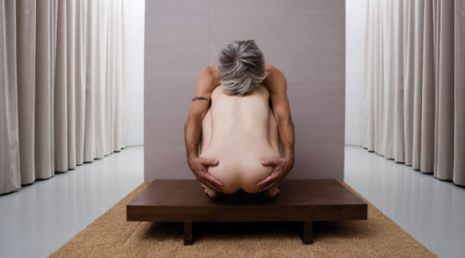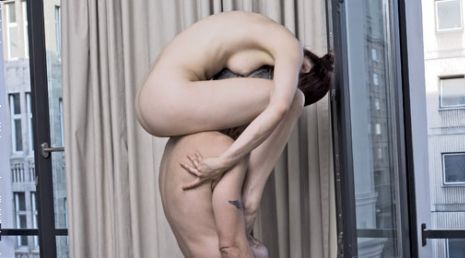Sense and Sensing
...Our working process has been a practice of listening ever more deeply to the myriad sensations passing through our bodies at any given moment. We bring our attention to sensations that in everyday life are usually filtered out. We observe the subtle, reflexive shifts that maintain our balance. We feel the movement of ribs as we breathe. We listen to our own hearts' beating.
We expand from these and other sensations, amplifying movement impulses, redirecting instinctual responses into territories at the extremes of our ranges of motion...
In western dance traditions, like ballet and modern dance, dancers are trained in a vocabulary of steps meant to be seen from the "front;" they practice daily in front of a mirror, and project themselves outward. Other choreographers and performers, like Curtis, discover movement - and the pieces that emerge from it - from the inside out. Work this way over a period of time and a subtle bodily sensitivity awakens, maybe even supplanting the habit of looking at yourself as if from afar, with visceral and kinesthetic awareness.
One could go there. The ballet and much of western theater in general was conceived as a spectacle for the king, with his vantage point as the optimal perspective. Isadora Duncan brought a much more three-dimensional perspective to the idea oh how dancing might be seen. In the sixties and seventies in dance the work of makers in Judson Church brought dance even more into accessible three-dimensional public spaces in the street or on rooftops or galleries further 'democratizing' it in a sense.
Those people made a different kind of seeing possible for dance. At this point I am working within those realms of possibility. I find that dancers who train all the time in front of mirrors have a tendency to dance two-dimensionally. Their bodies can tend to seem flat and lacking in depth.
I am interested in working with dancers who are not experiencing themselves in a single plane and also who are not experiencing themselves primarily through vision.
I think that feeling how one moves accesses much richer possibilities for creating movement. Of course, great ballet dancers do this as well. The more a performer is able to fully inhabit the multi-dimensionality of their action in terms of both its visibility and its tactile and proprioceptive qualities the more they can transmit that to a viewer and offer the audience more ways to experience the dancing as well.
The word presence can be a very useful way to describe this, but it can also be a bit of a trap. The move from representational (re-present-ational) art to art that highlighted the essential presence of the art object is one of the central qualities of the move into modernism. Painting went from being about making pictures 'of' something to being about putting paint on canvas.
Antonin Artaud is really the godfather of this move in terms of performance where he advocates that the living, breathing body of the actor on the stage should never be less important than the character he re-presents. In dance, Merce Cunningham is perhaps the most dramatic example of this shift and the whole Judson Church movement - even though they're referred to in dance circles as 'post-modern' - are really espousing these same modernist values.
Where it gets tricky is after this when people started to realize that even in this attempt at authenticity and essential presence there is an element of re-presentation. Jacques Derrida addresses Artaud in his essay The Theater of Cruelty and the Closure of Representation, to argue that there is ultimately no escape from representation. Re-presentation is where all meaning actually happens.
The attempt at presence is an important tool, but there is ultimately no 'there' there either. I do find the tension between the attempt at authenticity and its transmutation into a representational spectacle to be an incredibly powerful thing.
Examining felt experience has become more wide spread through such practices as Feldenkrais technique, Alexander Technique, and through what Body-Mind Centering founder Bonnie Bainbridge Cohen has described as "Sensing, Feeling and Action."
...writing about [an] experience, trying to describe things I only half remember. I find myself in this fiction mode where I can imagine the place that I once was and then I animate it and start the film rolling and describe what I imagine/remember. This is almost like documenting but it is different. What do I remember? What do I imagine? ...How is imagining a movement different from doing a movement? Is moving itself a kind of thinking...?
"Writing about my work allows me to process the work after the fact.
Writing gives people the possibility of a synesthetic (multi-sensorial) experience of the work that might make the work more useful to them in their life and practices.
Writing allows people at a greater distance to imagine the work.
Writing is a choreographic practice, inviting readers to embody elements of the choreographic systems involved in the work.
Writing allows me to talk about multiple experiences that went into the creation of the work.
Writing makes me re-imagine the work from a different perspective than doing the work.
Writing and reading can provide a bridge through time and space for the two of us to share common sensations...writing about...my work might provide you with a felt sense of the experience of making that work. Or it might...provide you with an opportunity to fantasize what the experience of making that work might feel like."
"Situating Documentation: or, Why I feel the need to write about my own dances?" Jess Curtis, unpublished manuscript.
Breathe,
Feel movement of ribs.
Adjust pelvic tilt.
Note sensational consequences in lower spine.
Increase space between lowest ribs and top of pelvis.
Breathe into that space.
Reach arms forward and up.
Spread fingers slightly.
Note consequential sensation in spine,
between shoulder blades and slightly below.
Follow impulse to expand this space.
Maintain integrity of relationship between pelvis and lower spine.
Note tension in thighs.
Continue to raise arms.
Keep head down.
Extend arms to edge of range.
Feel affect of this position;
reaching? asking? channeling?
Is something coming through you?
Maybe just this thought?
Is this "action" a "thought"?
Is the sensing of it a thought?
How is imagining it different from doing it?
As I remember it I feel it again.
"Symmetry Study #19 - Solo Medi(t)ations/Intersections," Jess Curtis, unpublished manuscript



